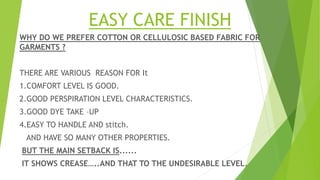
final easy care finish.pptx
- 1. EASY CARE FINISH WHY DO WE PREFER COTTON OR CELLULOSIC BASED FABRIC FOR GARMENTS ? THERE ARE VARIOUS REASON FOR It 1.COMFORT LEVEL IS GOOD. 2.GOOD PERSPIRATION LEVEL CHARACTERISTICS. 3.GOOD DYE TAKE –UP 4.EASY TO HANDLE AND stitch. AND HAVE SO MANY OTHER PROPERTIES. BUT THE MAIN SETBACK IS...... IT SHOWS CREASE…..AND THAT TO THE UNDESIRABLE LEVEL.
- 2. CREASE- CREASE ARE THE FOLD IN FABRIC INTRODUCED UNINTENTIONALLY DURING WASHING ,RUBBING AND IN VARIOUS OTHER PROCESSES. WHY CREASE ARE FORMED • CREASE ARE FORMED BECAUSE OF TENDENCY OF FABRIC TO ABSORB MOISTURE. • THE TENDENCY TO DEVELOP CREASE IS ALSO DUE TO THE PARTIALLY AMORPHOUs STRUCTURE OF THE CELLULOSE WHICH MEANS THAT STRUCTURAL CHANGE CAN OCCUR QUITE EASILY. HENCE ,VARIOUS CHEMICALS AND PROCESS ARE APPLIED TO OVERCOME OR REDUCE THE EXTENT OF CREASE FORMATION.
- 3. EASY CARE FINISH EASY CARE FINISH ARE GENERALLY APPPLIED TO CELLULOSE AND CELLULOSIC BLENDS FABRIC . IT IS A CHEMICAL MODIFICATION OF FIBROUS CELLULOSE RESULTING FROM A HETEROGENEOUS REACTION WITH A DI-FUNCTIONAL OR POLYFUNCTIONAL REAGEN WHICH GENERATES RESILIENCE IN COTTON CONTAINING FABRICS BY CROSS - LINKING.IT OCCURS AT THE HYDROXYL GROUP SITES.
- 4. WHY DO WE NEED EASY CARE FINISH 1. REDUCTION IN SWELLING AND SHRINKAGE . 2. IMPROVE WET AND DRY WRINKLE RECOVERY. 3. SMOOTHNESS OF APPEARANCE AFTER DRYING.
- 5. MECHANISM OF EASY CARE FINISH THE PRIMARY CAUSE OF SHRINKAGE IN COTTON IS ITS ABSORBTION OF MOISTURE. THIS ABSORBED MOISTURE FACILITATES INTERNAL POLYMER CHAIN MOVEMENT IN THE AMORPHOUS FIBRE AREAS THAT DISRUPTS THE INTERNAL HYDROGEN BONDING BETWEEN THESE POLYMAER CHAIN. WHEN CELLULOSE WITH MOISTURE IS STRESSED THE POLYMER CHAIN SHIFTS ITS POSITION AND WITH NO RESTORING FORCE AVAILABLE ,A NEW WRINKLE OR CREASE IS FORMED AND IT WILL REMAIN UNTIL IRONING IS APPLIED TO OVERCOME THE INTERNAL FORCE.
- 6. THERE AARE VARIOUS TYPES OF FINISHES APPLIED TO COTTON. ANTI -CREASE FINISH. WASH AND WEAR FINISH. DURABLE PRESS FINISH. ANTI –CREASE FINISH TWO DIFFERENT CHEMICAL PROCESS ARE USED— 1. THE INCORPORATION OF A POLYMERIZED FINISH IN THE PORES OF FIBRE ,SO THAT WATER MOLECULES CAN NOT EASILY PENETRATE THE FIBRE. 2. THE REACTION OF MULTI FUNCTIONAL CROSS LINKING AGENTS (RESINS) WITH HYDROXYL GROUP OF CELLULOSE MOLECULES THAT HINDER THE SWELLING OF CELLULOSE FIBRES. 3. RESINS ARE USED AS IT CREATE STRONGER (COVALENT) AND PERMANENT BOND WITH FABRIC THAT REDUCES CREASING TO A LARGER EXTENT. 4. EXAMPLES ARE---- UREA FORMALDEHYDE RESINS MELAMINE FORMALDEHYDE RESINS.
- 7. DMU reaction with cellulose
- 8. WASH- AND WEAR –FINISH IN THIS PROCESS , THE H- ATOM IS REPLACED BY ANY OTHER GROUP SO AS TO PREVENT CHLORINE TAKE UP.
- 9. DURABLE PRESS FINISH 1.THE REQUIRED CREASES OR PLEATS NECESSARY FOR CERTAIN FABRIC ARE OBTAINED IN THIS PROCESS. 2. CROSS LINKING AGENT AND A CATALYST ARE APPLIED TO FABRIC .
- 11. Pre cure- In this process, the fabric is generally impregnated with resin precondensate and /or cross-linking reactants and catalysts. The impregnated fabric is then dried and cured at high temperature to obtain the cross-linking effect. The curing temperature and time are dependent on the types of cross-linking agents and fabrics. The sequence of pre-cure processes is as follows : (i) Impregnation. (ii) Drying at 80°c – 100°c temperature. (iii) Curing at 150°c temperature for 4 – 5 minutes. (iv) Cutting, sewing and making-up.
- 12. Post cure- The post-cure process also known as deferred curing process is basically different from conventional finishing techniques. In this process the fabrics is impregnated with appropriate reactant, catalyst and other finishing agents and dried carefully so that no curing occurs. This uncured fabric is referred to as sensitized cloth, and after pressing to shape, they may be cured in an oven. The following temperatures are generally employed: Pressing: 5 – 15 seconds at 120 – 165°c Curing: 10 – 18 minutes at 170 – 190°c The post cure process produces garments with outstanding easy care finishing properties.
- 13. ADVANTAGES OF ECF- EASY CARE AND WRINKLE RESISTANCE DIMENSIONAL STABILITY DURABLE PRESS ANTI PILLING FIXATION OF DYESTUFF AND PIGMENTS
- 14. DISADVANTAGES OF ECF- LOSS OF ABRASION,TEAR AND RIPPING STRENGTH. GRAYING DURING WASHING. REDUCTION OF LIGHT FASTNESS AND SHADE CHANGES OF COLOURED FABRICS. CHLORINE RETENTION,CAUSING MARKED YELLOWING AND STRENGTH LOSS.
- 15. THANK YOU